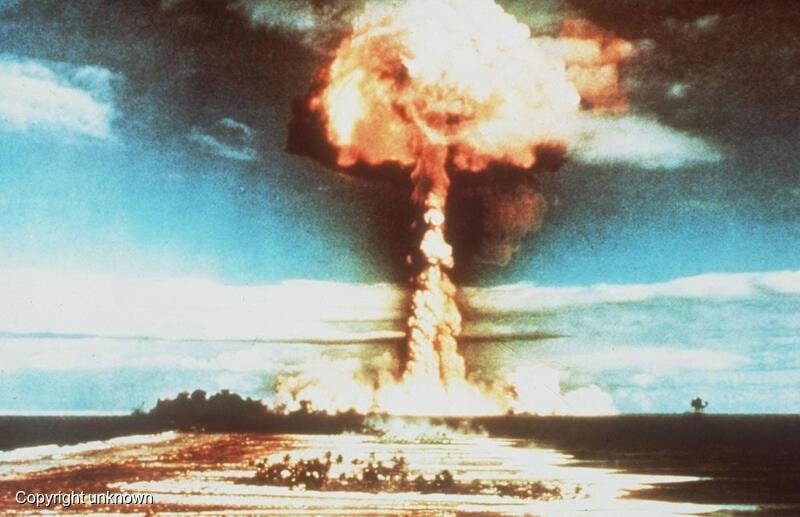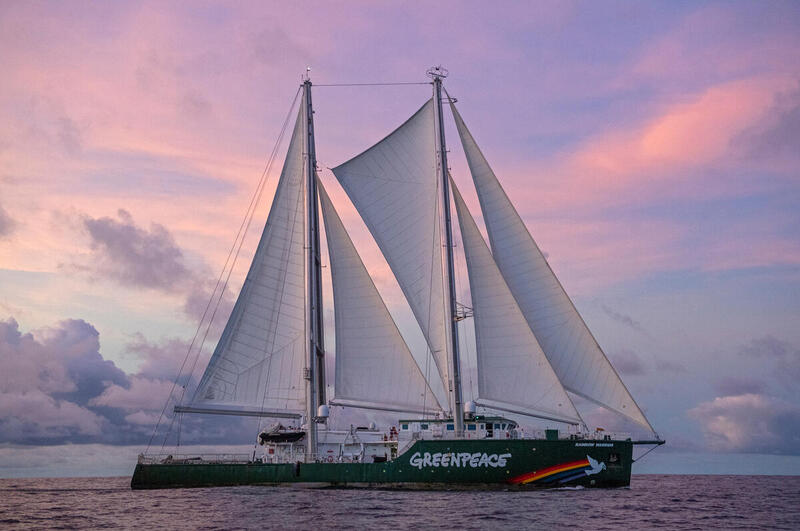A photographer looks back at Greenpeace’s early years
From 1974 to 1982, I served as photographer on Greenpeace campaigns. Here are a dozen more photographs from those years along with some memories that they evoke:
Whale campaign announcement, Vancouver, 1975
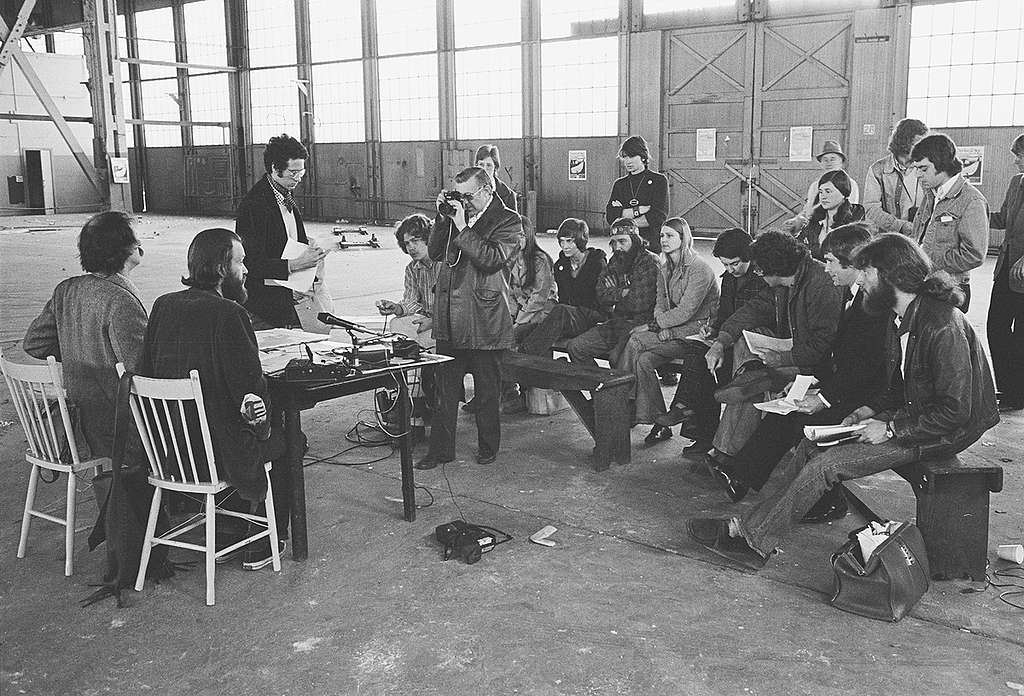
Greenpeace, originally an anti-war group, had been active in local ecological issues in Canada, but wanted to stage an ecology action that would have global impact. In 1972, Canadian whale scientist Paul Spong met author Farley Mowat — who had just published A Whale for the Killing — and learned about the near-collapse of whale populations in all oceans of the world. Spong came to Greenpeace, wanting to use the sea-going confrontation tactics to stop the whale slaughter. This was it! We all felt that this campaign would help launch a global ecology action movement, and we set to work.
Captain Cormack, who skippered the first Greenpeace action to stop nuclear bomb testing, agreed to contribute his services and his fishing boat. In February 1975, we announced the plan to the public in an abandoned Canadian Navy hanger at Vancouver’s Jericho Beach. Event promoter Alan Clapp (left, sitting next to Bob Hunter) negotiated with the Navy, and organized the media conference. Crew member, musician Mel Gregory sits in the centre (with a headband). Engine and inflatable-boat mechanic, Carlie Trueman, stands behind (in pigtails). Vancouver activist and campaign media director Rod Marining sits on the far right. At the time, this felt like just another day in the campaign; in retrospect, this was the moment that Greenpeace announced to the world that we would put human lives in harm’s way to save other creatures, that there was going to be a global ecology movement to save the Earth.
Rose Harbour, abandoned whaling station
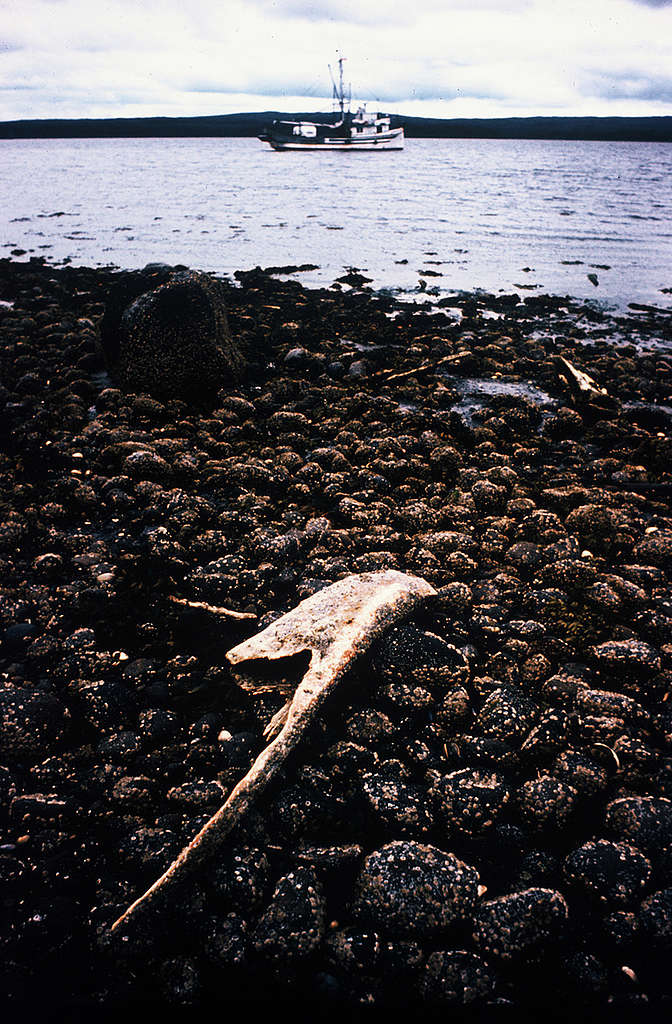
In 1975, we headed out in the fishing boat, Phyllis Cormack, to find the whalers, somewhat naive about the task before us. As we headed north along the west coast of Canada, we tucked into Rose Harbour on Kunghit Island, the southern tip of Haida Gwaii, and discovered this abandoned whaling station.
The Haida, Inuit, and other Aboriginal nations practiced sustainable sustenance whaling for centuries before colonization by Europeans. On the other hand, industrial, commercial whaling on Canada’s west coast lasted only 61 years, from 1905 to 1967. Rose Harbour was one of five shore stations that processed whales, including Blue, Fin, Humpback, Sei, Sperm, Right, Gray, Minke, and Baird’s beaked whales. Some 25,000 whales were caught before the populations collapsed and the industry closed. The beach at Rose Harbour was still littered with whale bones, rusting winches, and harpoon heads. It felt as if we had stumbled upon the remains of a horrendous battle, a lasting reminder of the limits to humanity’s industrial plunder of our fragile Earth.
Glaucous-winged gull, Triangle Island, west coast of Canada
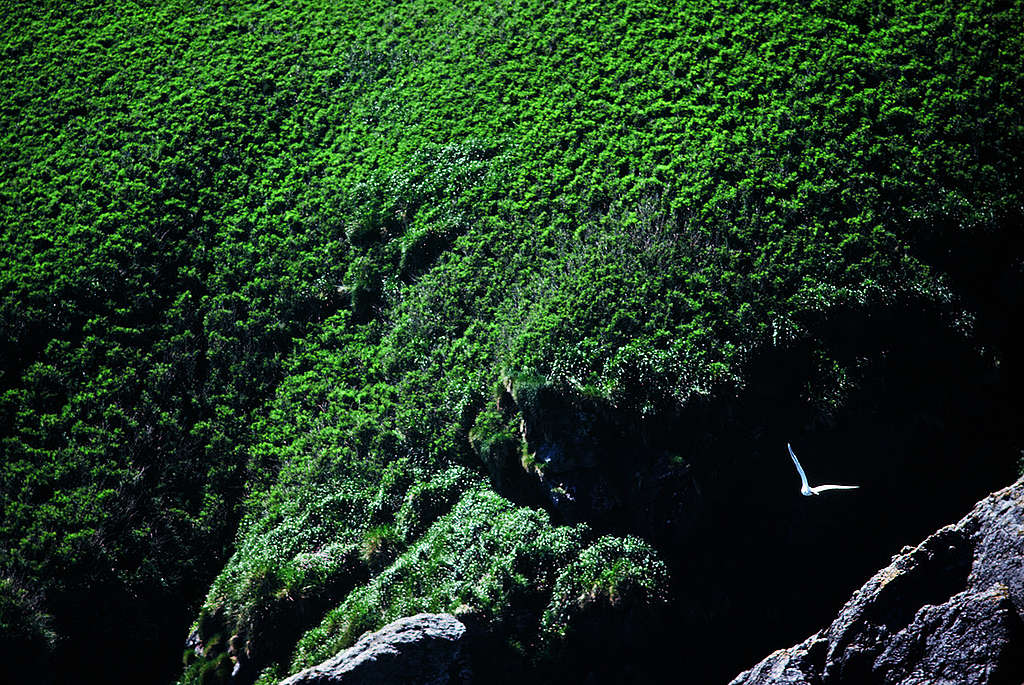
During the first whale campaign in May 1975, we passed by remote Triangle Island on our way to the Dellwood Seamounts where we thought we might find whaling fleets. We spent a morning out of the wind, preparing to venture into the open ocean. This photograph reminds me of what a relationship to the ecology of one’s habitat meant for me then, and still now: Protecting what is wild and free in the world, unencumbered by human cleverness and enterprise.
I sometimes dream of a world in which all creatures, including humans, could conduct their relationships with their habitat in peace. Flocks of petrels fly each night into these remote rocks and burrow under the wind-pruned salmonberry and salal. Gulls, cormorants, auklets, oyster-catchers, and other sea birds nest among the rocks here and north along the coast of Haida Gwaii. We didn’t find the whalers at the Dellwood Seamounts, but we began to learn how to be a half-decent ship’s crew.
‘Whale War’ story in San Francisco Chronicle
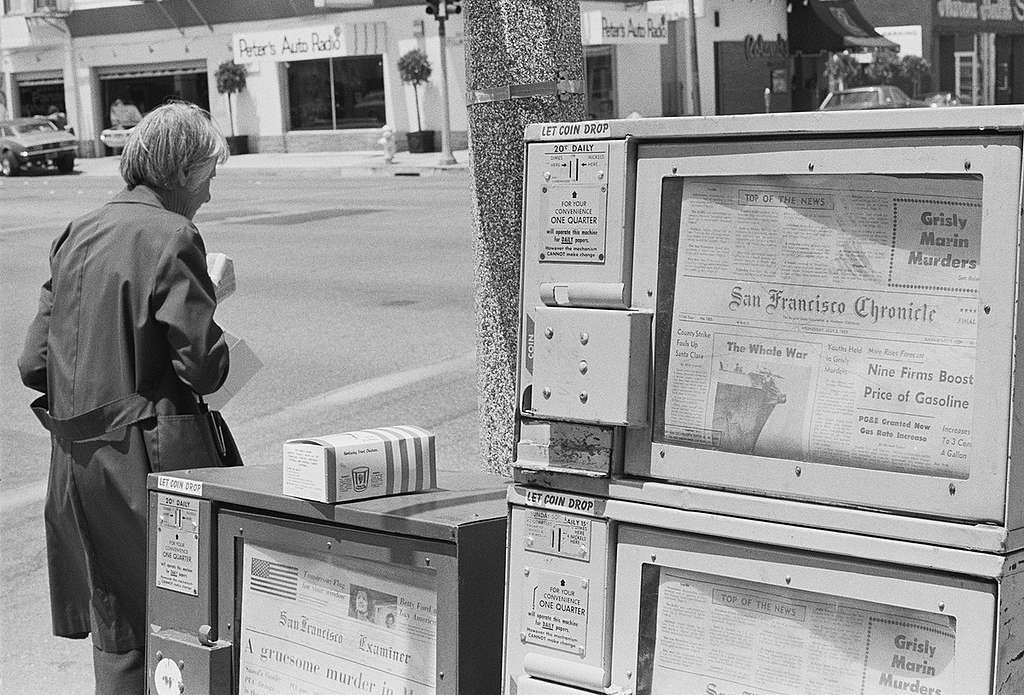
After the first whale confrontation with Russian whalers in 1975, we had to travel two days into San Francisco to process film and send images out on the wire services. Of course, there was no Internet, and we had no capacity to process film on board our vessel. When we arrived at the dock in San Francisco, all the major media services — UPI, AP, Reuters, and so forth — met us and clamored for pictures. We made an agreement with The Associated Press to process the film at their studio and make images available to all the services. The 16mm film aired that night on CBS News in the United States. I rose early the next morning, and headed straight out to find the newspapers, to see if my images appeared. “Above the fold” on the front page was comparable to being on top of the Google search today. When I saw the harpoon ship image on the cover of the San Francisco Chronicle, I captured the moment.
Later at the newsstand, I saw our photographs in most of the world’s newspapers. Today, we move so many images around the world, so quickly, it might be difficult to imagine how this felt in 1975, but, this felt to me like the achievement of a goal two years in the making. Greenpeace was never the same after this day. Our little Canadian peace and ecology project was about to go global.
Walrus and Bob Hunter, Tofino pub, 1976
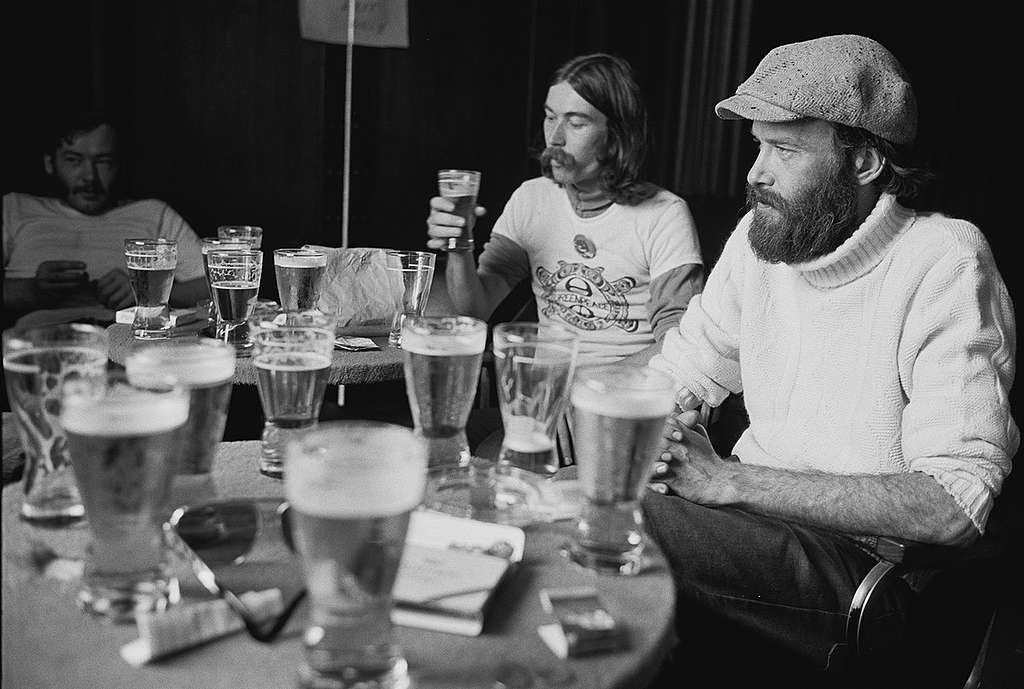
© Greenpeace / Rex Weyler
In 1976, we chartered a Canadian minesweeper, the James Bay, that would be able to go farther into the Pacific and could keep pace with the whaling fleets. This photograph was taken on the last day in Canada, before departing to find the whalers, who were operating near Hawaii. Prior to 1975, Greenpeace had no public office, and we often met in our own kitchens, in coffee shops, and in pubs. The skipper, John Cormack, and others on the crew, did not drink, but pub culture was part of Greenpeace history. Many campaigns were conceived and fleshed out in Canadian pubs.
David “Walrus” Garrick (left) was the ship’s cook and Greenpeace librarian, with a vast collection of ecology journals, legislation, and books, essentially the search engine of our movement. Bob Hunter, the author of The Storming of the Mind, Warriors of the Rainbow, and other books was already a Canadian media legend, a brilliant campaign strategist, and a life-long ecologist. In 2003, Hunter wrote Thermageddon: Countdown to 2030, about global heating from human carbon emissions, and our failure to act on the science.
Bob Hunter touches a harpoon ship, 1976
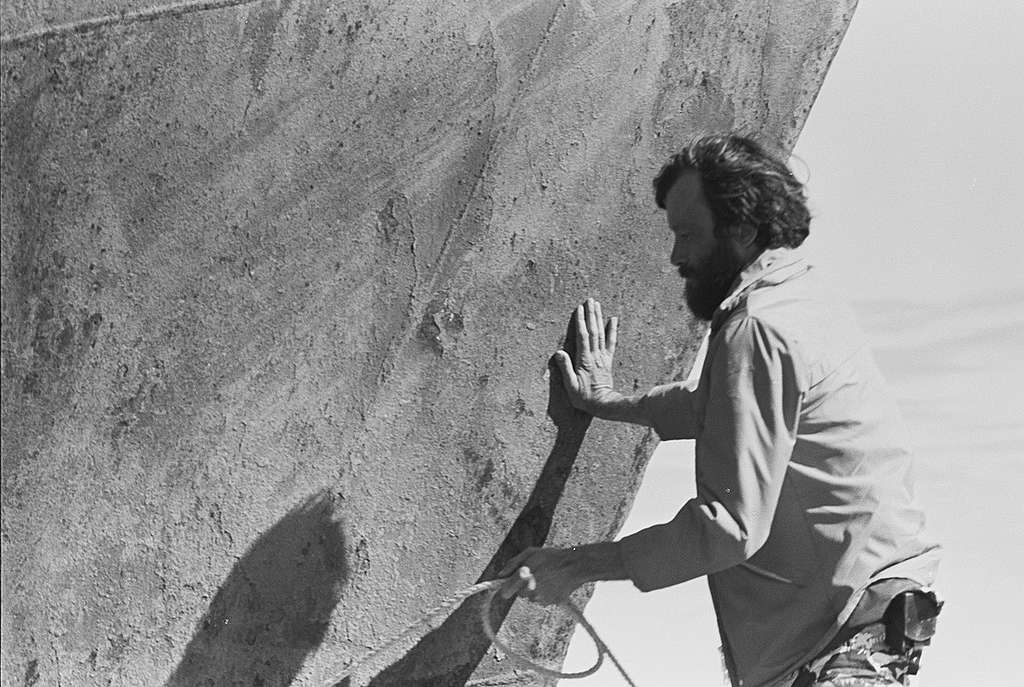
In 1975, we first disrupted the Russian Pacific whaling fleet. In 1976, we actually stopped this harpoon ship dead in the water. The previous year, they had fired a 250-pound exploding harpoon over our heads, killing a female Sperm whale, and our films and photographs of that encounter circled the globe via public media. Obviously, word had come down from the Soviet bosses to avoid confrontation, so when we disrupted the hunt this year, the ships throttled down and stopped. We had been working on this campaign for three years, we were all exhausted, we were broke, and operating on borrowed money. No one was getting paid. Bob was in tears as we approached this idle ship. He reached out and laid his hand on the rusting hull. This was a culmination of the dream we had nourished for three long years, and the moment felt historic.
Aerial photograph of Harp seal slaughter, 1978
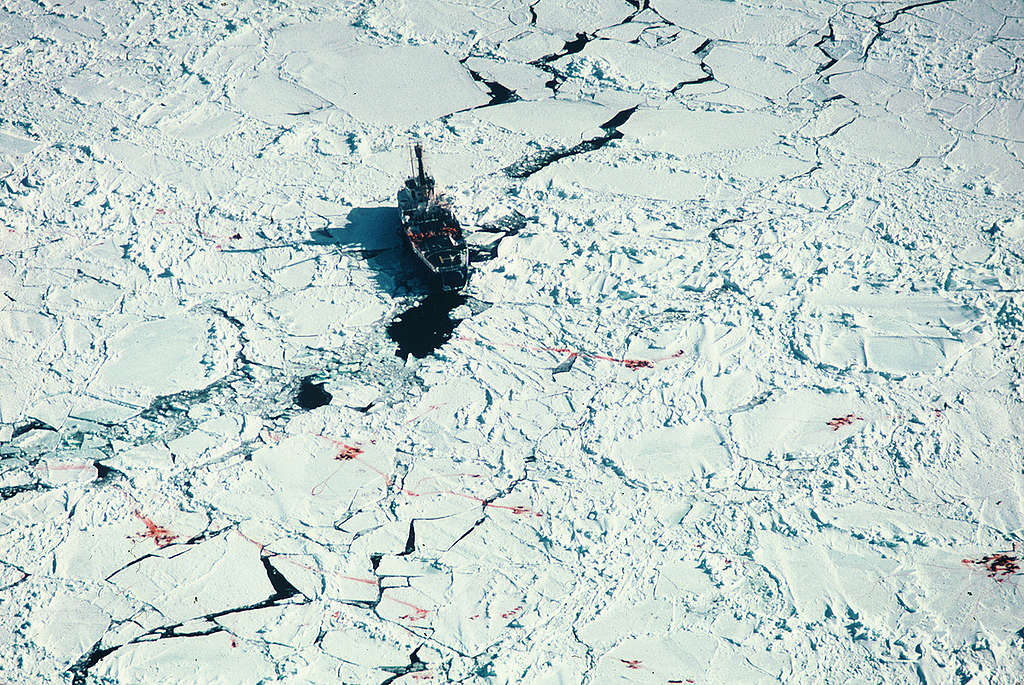
Probably the most heartbreaking campaign I ever worked on was to stop the slaughter of weeks-old infant Harp seals off Labrador coast in eastern Canada. Industrial-scale ships from Norway had been appearing on the ice floes for years, clubbing infant seals only weeks old, because their white coats were highly prized by the fashion industry. This photograph was taken from our helicopter, looking down on the ravaged seal nursery. On the ice, the cries of the infant seals tore me up, as they sounded so much like a human infant in pain. Most of us were in tears before we left.
This campaign brought us into conflict with some Newfoundlanders, who got a few weeks of work from the Norwegian fur companies. In the end, we compromised with the “landsmen,” who hunted seals near the shoreline, avoiding a clash with the local hunters, and focusing on the Norwegian industry and the European fashion trade. The eventual ban on seal furs in Europe also hurt some of our Indigenous friends in Canada, who hunted seals. The Inuit people, for example, objected to our campaign because even though they were not the target, the ban in Europe affected their lives. The Inuit hunted seals for subsistence, and the lean meat is rich in iron, zinc, and vitamins. Greenpeace apologized for the disruption and agreed to avoid any conflict with the Indigenous seal hunt.
Our action in Labrador, however, may have saved the Harp seal from extinction, and certainly gave thousands of seal pups the opportunity to mature and live a normal seal’s life.
Allen Ginsberg arrested at Rocky Flats, Colorado, 1978
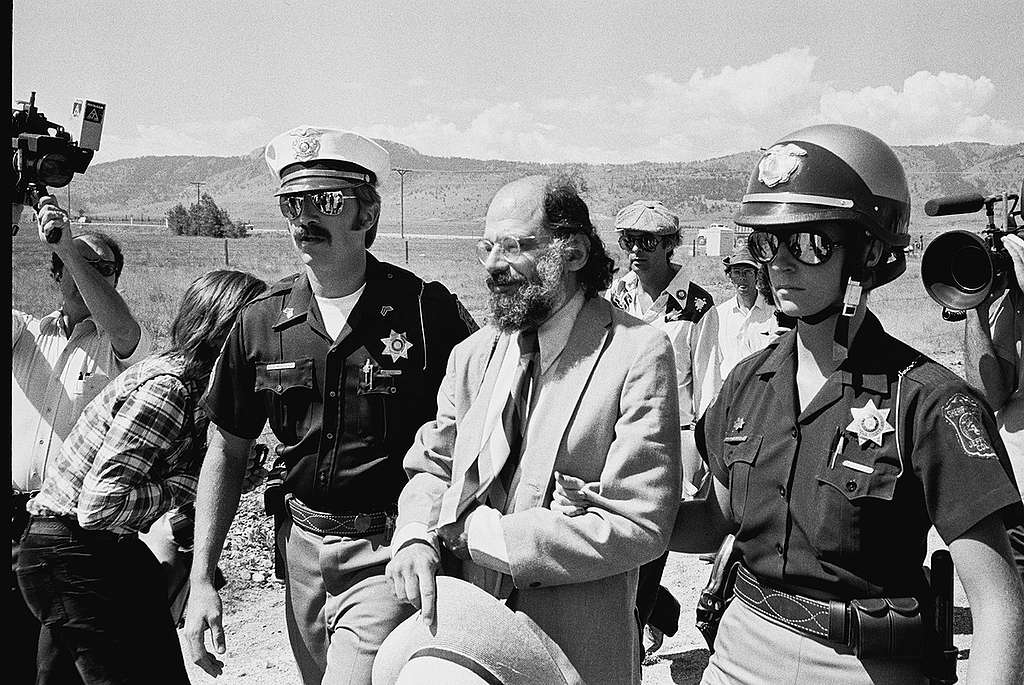
Bob Hunter and I had met Allen Ginsberg in Vancouver, and shared ideas about ecology, Buddhism, and direct action. Meanwhile, I was working with a Colorado group, The Rock Flats Truth Force, in an alliance that included Greenpeace, to close the Rocky Flats nuclear facility that made the triggers for the entire US nuclear weapons arsenal. The soil and air around the facility were contaminated with tritium and other radioactive by-products, and Colorado doctors had linked the cancer spike in the region to this contamination.
Ginsberg taught at the Buddhist Naropa Institute in Boulder, near the nuclear factory. He had just written a now-famous poem, “Plutonian Ode”: “My oratory advances on your vaunted Mystery … Behind your concrete & iron walls, inside your fortress ..” We attended his poetry reading in Boulder and invited him to the occupation of the Rocky Flats site. Ginsberg sat with others on the rail tracks, blocking shipments of uranium to the site, and was arrested. Ginsberg was a committed pacifist and ecologist, one of my mentors and heroes. He passed away in 1997, leaving behind a vast record of poetry, documenting decades of social upheaval, spiritual insight, and creative consciousness.
Anti-nuclear protest, New Hampshire, 1980
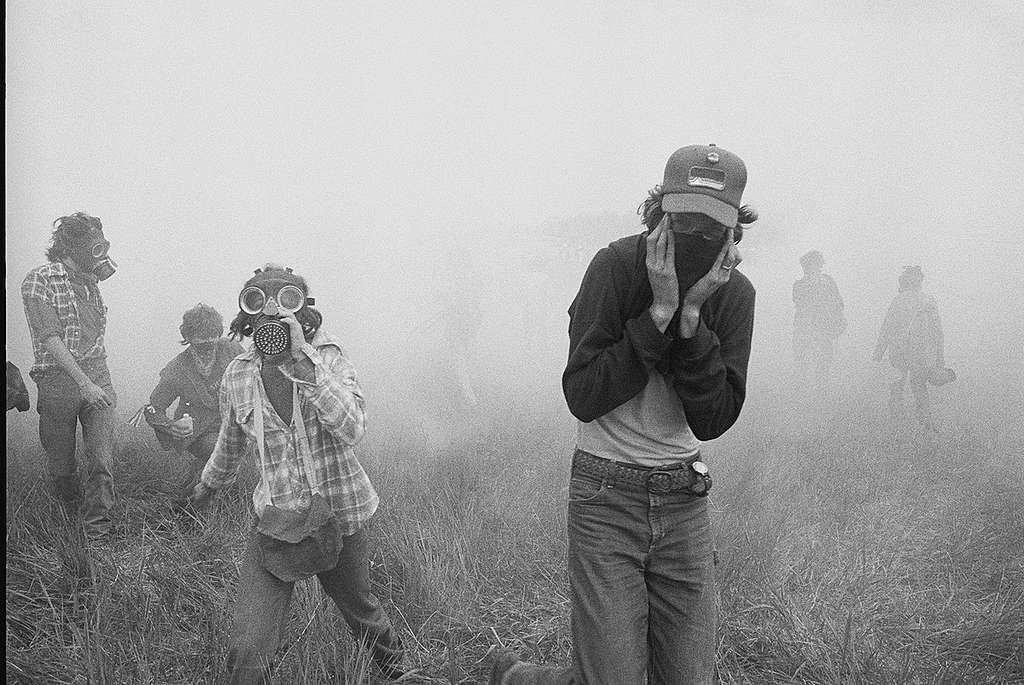
The Clamshell Alliance had been formed in 1976 to oppose the Seabrook, New Hampshire power station. I had become friends with photographer Lionel Delevingne, who was documenting the anti-nuclear movement, and we went to Seabrook together in the summer of 1980. Some 3,000 activists arrived at the site, some began to cut through wire fencing, and others blocked delivery of the plant’s first nuclear reactor containment vessel. Police attempted to clear the road and fence line with tear gas, shortly before this picture was taken.
The Clamshell Alliance, a decade before the Chernobyl meltdown, inspired clean energy activists around the world by following Albert Einstein’s advice to take “the facts of atomic energy .. to the village square”. Since then, Chernobyl, Fukushima, a still-intact nuclear weapons arsenal, a persistently unsolved nuclear waste boondoggle, the impact of radioactivity, and the carbon-cost of mining, confirm that nuclear energy is still not remotely green or peaceful.
Oil tanker action, Juan de Fuca Strait, 1981
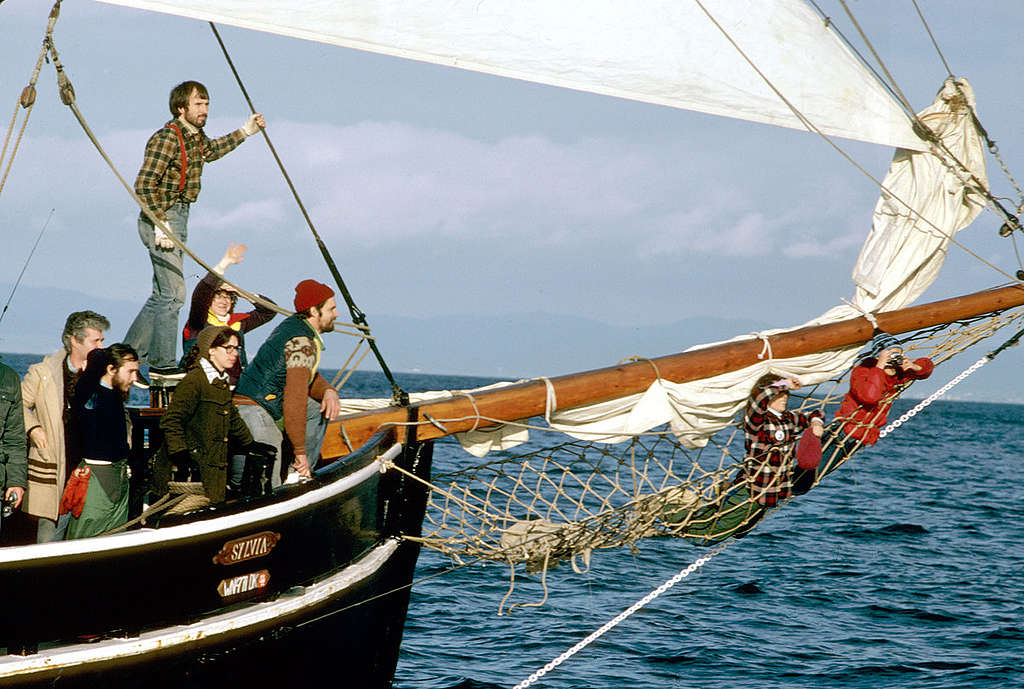
In January of 1981, as we worked in our Vancouver Greenpeace office, Rod Marining read in the newspaper that an oil consortium planned on bringing an oil tanker in the Salish Sea, the inside strait between the Canadian mainland and Vancouver Island. They announced that the tanker would only be loaded with water and they intended to demonstrate how safe it would be to build an oil port in these waters. The tanker was expected in a few days, they announced, and was “just a test.”
As we discussed what to do, our office manager Julie McMaster said off-handedly, “Why don’t you stage a test blockade?” We all laughed. Yes, this would be perfect. We announced that day that we were launching a “test blockade” of the supertanker, the S/S B.T. San Diego, a 188-thousand tonne oil tanker, the largest ever built on the west coast of North America. We organized a flotilla of boats from Vancouver, Victoria, and Seattle, and headed out to Juan de Fuca Strait, the entrance from the Pacific. This photograph shows our friends from Seattle, who had opened a Greenpeace office there. We stopped the tanker dead in the water and were arrested by the US Coast Guard. As they hauled us up the wharf in Washington, we told the media that this was “just a test” and we were going to now test the local jail. The police appeared to be on our side, and treated us kindly. They went out to buy us dinner, returned with a large bag of sandwiches, dropped it on the table in the middle of our cell and said, “Test this.” The supertanker campaign was always one of my favorites because the idea came spontaneously from our office manager, and we organized the entire project in a few days, we spent almost no money, the “just a test” humour endured through the whole exercise, and best of all, we won over public and political sentiment.


